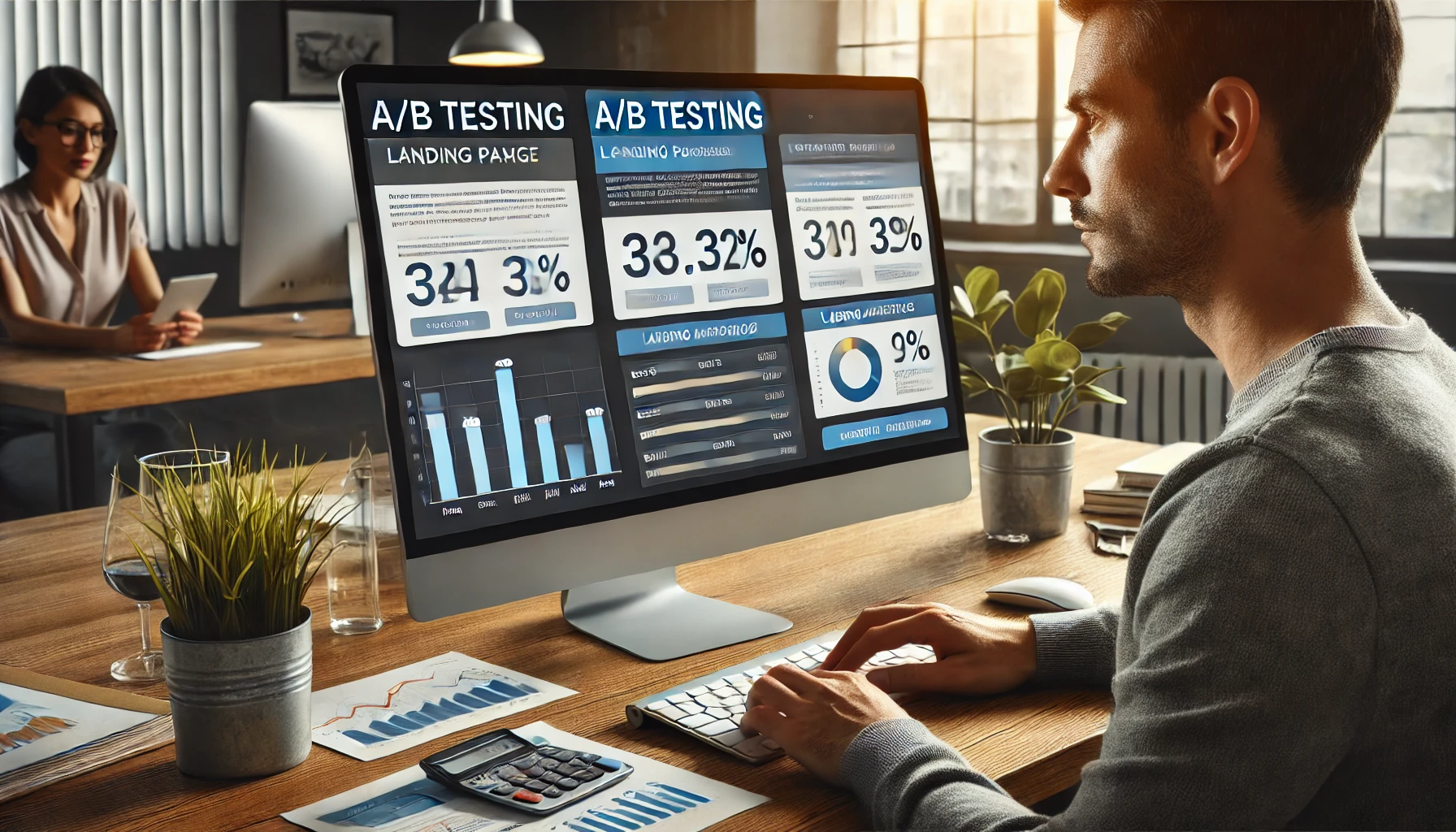A/B testing (also called split testing) is one of the most powerful strategies for optimizing paid traffic campaigns. It allows you to compare two variations of an ad, landing page, or targeting strategy to determine which one delivers better results and higher ROI.
Without A/B testing, businesses waste money on underperforming ads and miss opportunities to increase conversions at a lower cost.
In this guide, you’ll learn how to use A/B testing to improve paid traffic campaign performance and scale effectively.
1. What is A/B Testing and Why is It Important?
📌 A/B Testing = Comparing two versions of an ad, landing page, or campaign to see which performs better.
✅ Why A/B Testing is Essential in Paid Advertising:
✔ Reduces Wasted Ad Spend → Stop running ads that don’t convert.
✔ Increases Click-Through Rate (CTR) → Find headlines and images that attract more clicks.
✔ Lowers Cost Per Click (CPC) & Cost Per Lead (CPL) → Optimize creatives to get more results for less money.
✔ Boosts Conversion Rates → Improve landing pages and ad copy for higher sales.
💡 Pro Tip: Even a small improvement (5-10%) in CTR or conversion rate can significantly lower ad costs and increase profitability.
2. What Elements Should You A/B Test?
A/B testing can be applied to multiple parts of your campaign. The key is to test one variable at a time to see exactly what is improving or hurting performance.
📌 Key Elements to A/B Test in Paid Traffic Campaigns:
| Element | What to Test | Impact on Campaign |
|---|---|---|
| Headlines | Short vs. long, question vs. statement | Affects CTR & engagement |
| Images & Videos | Product images vs. lifestyle shots | Impacts ad engagement & CPC |
| Call-to-Action (CTA) | “Sign Up Now” vs. “Get Your Free Guide” | Affects conversion rate |
| Ad Copy | Emotional vs. data-driven messaging | Influences CTR & engagement |
| Landing Page Design | Form placement, colors, CTA button size | Affects bounce rate & conversions |
| Targeting | Different age groups, interests, locations | Impacts CPL & ROAS |
| Bidding Strategy | Manual CPC vs. Maximize Conversions | Influences overall ad cost |
💡 Pro Tip: Start by testing high-impact elements like headlines, CTA buttons, and images, then refine smaller details.
3. How to Set Up an A/B Test (Step-by-Step Guide)
✅ Step 1: Choose One Variable to Test
✔ Pick one element to test at a time (e.g., CTA, image, ad copy).
✔ If you change multiple elements, you won’t know what caused the difference in performance.
✅ Step 2: Create Two Variations (A & B)
✔ Version A (Control) – Your original ad or landing page.
✔ Version B (Variation) – A slightly different version (e.g., different CTA).
✅ Step 3: Split Traffic Evenly
✔ Ensure that both versions are shown to an equal number of users.
✔ Most platforms (Facebook Ads, Google Ads) allow automatic A/B audience splitting.
✅ Step 4: Run the Test for At Least 7 Days
✔ Let the test gather enough data before making conclusions.
✔ Avoid stopping early if one variation starts winning too soon—results may fluctuate.
✅ Step 5: Analyze the Results & Apply Changes
✔ Compare CTR, conversion rate, CPL, and ROAS between A & B.
✔ Pause the underperforming version and scale the winning one.
✔ Use insights to test new variations for continuous improvement.
💡 Pro Tip: Run A/B tests for at least 1,000 impressions or 100 conversions for statistically valid results.
4. A/B Testing in Different Paid Advertising Platforms
📌 A/B Testing in Facebook & Instagram Ads
✔ Use Facebook’s A/B Testing Tool to test different ad creatives & audiences.
✔ Duplicate an ad and change one variable (e.g., CTA, image, or targeting).
✔ Let both versions run for at least 5-7 days before making adjustments.
💡 Pro Tip: Facebook automatically shifts budget to the best-performing ad—disable this if you want a true A/B test.
📌 A/B Testing in Google Ads (Search & Display)
✔ Use Google Ads Experiments to test bidding strategies, keywords, and landing pages.
✔ Run Responsive Search Ads (RSA) to let Google test different headlines automatically.
✔ Check Search Term Reports to see which keywords drive more conversions.
💡 Pro Tip: In Google Ads, testing different ad extensions (site links, callouts) can improve CTR and lower CPC.
📌 A/B Testing in LinkedIn Ads
✔ Run Sponsored Content A/B Tests with different ad copy and CTA buttons.
✔ Test LinkedIn Lead Gen Forms vs. Website Landing Pages to see which converts better.
✔ Compare different audience segments (e.g., CEOs vs. Marketing Managers) for lower CPL.
💡 Pro Tip: LinkedIn Ads tend to be more expensive—optimize first before scaling.
📌 A/B Testing in YouTube & TikTok Ads
✔ Compare different video thumbnails & hooks (first 3 seconds are crucial).
✔ Test short-form vs. long-form video ads for engagement.
✔ Experiment with different CTAs (Shop Now vs. Learn More) to see what drives conversions.
💡 Pro Tip: YouTube Ads perform better with strong CTAs at the start (not just the end of the video).
5. Common A/B Testing Mistakes (and How to Avoid Them)
❌ Mistake #1: Testing Too Many Variables at Once
✅ Fix: Test only one element at a time to get clear insights.
❌ Mistake #2: Stopping the Test Too Soon
✅ Fix: Let the test run for at least 7 days or 1,000 impressions.
❌ Mistake #3: Using Small Sample Sizes
✅ Fix: Ensure your test has enough traffic for meaningful results.
❌ Mistake #4: Ignoring Statistical Significance
✅ Fix: Use A/B Testing Calculators (Google Optimize, VWO) to check if results are valid.
❌ Mistake #5: Not Applying Test Insights to Future Campaigns
✅ Fix: Use winning elements in new ads and continue testing.
Final Thoughts: Using A/B Testing to Improve Paid Traffic Campaigns
A/B testing is an essential tool for optimizing paid traffic performance. By continuously testing ad creatives, targeting, and landing pages, businesses can lower costs, increase engagement, and maximize conversions.
📌 Key Takeaways:
✅ Test one element at a time (headlines, CTAs, images, etc.).
✅ Run tests for at least 7 days or 1,000 impressions.
✅ Use platform-specific tools like Google Ads Experiments & Facebook A/B Testing.
✅ Track CTR, CPC, CPL, and conversion rates to measure success.
✅ Apply winning elements to future campaigns for continuous improvement.
🚀 Now it’s your turn! Start running A/B tests and take your paid traffic campaigns to the next level!




